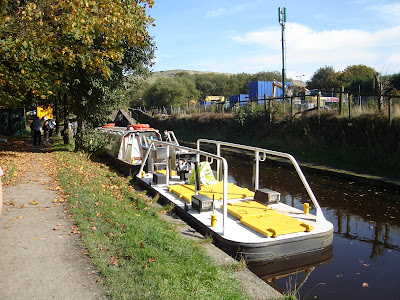 Steam bus 'Elizabeth' at the RVP this morning with Vernon on the left, our conductress in the centre, and the regular fireman on the right.
Steam bus 'Elizabeth' at the RVP this morning with Vernon on the left, our conductress in the centre, and the regular fireman on the right.Sentinel steam bus 'Elizabeth' is at operating at the Runway Visitor Park this weekend. Knowing she was coming from her base in Whitby, I e-mailed Vernon, her owner / driver, introduced myself as a guide at the RVP and a passed fireman on the MoSI steam railway, and asked if it would be possible to have a go at firing 'Elizabeth'. Decent chap that Vernon is, he readily agreed. So this morning at the RVP instead of my usual guide uniform of white short-sleeve shirt and Concorde tie with navy blazer I wore my oily boiler suit and protective boots.
When I arrived, 'Elizabeth' was gently simmering by the bus stop near the entrance. I parked, donned the overalls and boots, and introduced myself to Vernon. Vernon is an ex-driver on the North York Moors Railway and we had a chat about railways, steam, and the difference between steam locomotive and steam road vehicle driving and firing.
 A view into the cab through the driver's door
A view into the cab through the driver's door The driving side of the cab as seen from the fireman's side, with the vertical boiler between the two
The driving side of the cab as seen from the fireman's side, with the vertical boiler between the twoVernon invited me up into the cab and showed me 'the taps', and asked me to shoot four shovels full of coal onto the fire to bring the pressure up. Meanwhile, he operated the engine-driven feed pump to increase the water level in the boiler (there is also a live steam injector).
 The top of the vertical boiler in the cab. Coal is shovelled down the hole in the centre, to drop through to the firebed beneath the boiler. There is a 'lid' for the firehole just to the right of it, but to allow sufficient 'top air' to the fire this is usually left off.
The top of the vertical boiler in the cab. Coal is shovelled down the hole in the centre, to drop through to the firebed beneath the boiler. There is a 'lid' for the firehole just to the right of it, but to allow sufficient 'top air' to the fire this is usually left off.We had a few passengers by now so it was time to go. Almost silently, with just a whirr from the gears and drive chains, we chuffed away down the lane towards 'The Romper' pub. Here Vernon executed a three-point turn at the cross roads so we could return to the RVP.
 The coal bunker in the cab between the crew seats
The coal bunker in the cab between the crew seatsAs we waited for more passengers Vernon explained to me more about the operation of 'Elizabeth', especially on her regular stamping ground in Whitby, Yorkshire. The pressure gauge had fallen to about 120 PSI by now so I put another six shovelfuls onto the fire and pretty soon it was climbing towards the red line at 200 PSI and it was once again time to go.
 Vernon took this one of me.... another 'steam dream' achieved; firing a steam bus!
Vernon took this one of me.... another 'steam dream' achieved; firing a steam bus!I did one more return trip before handing over to the regular fireman. What a great way to spend a Saturday morning; thanks Vernon - I really enjoyed that!
And tomorrow - off to MoSI to fire either 'Agecroft No.1' or 'Planet'.
.


































